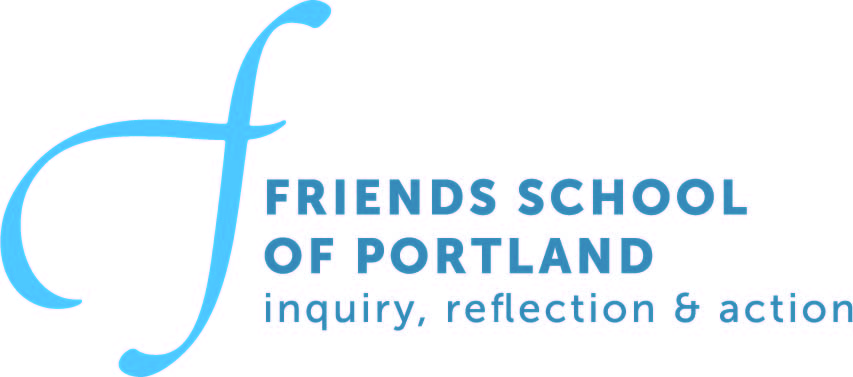Pictured above: Kindergarten teacher, Carie, with students out at the Outdoor Classroom on a wintery day.
Approximately every fourth Friday, faculty members meet in three groups (the administration comprises a fourth group) and when 3:30 pm hits, they emerge from these intimate subgroup meeting areas with bright eyes, sometimes laughing, and usually taking longer to leave than normal.
Critical Friends Groups are a National School Reform initiative, a peer-to-peer form of professional development started in the 1990s. The “Friends” in CFG is not Quaker, though I did first experience CFGs at a Quaker retreat at Pendle Hill. And though the word “Critical” can be intimidating, the experience is anything but – it is validating and empowering, though it does often push people out of their comfort zones. These small communities consist of at least five adults who commit to looking seriously at their educational practice and making changes or revisions, using a structured interaction (called a protocol). As the first stage, a foundation of trust and intention is built by a facilitator.
FSP's first cohort of nine teacher facilitators were trained last summer to lead CFG protocols. For each monthly meeting, the facilitator meets ahead of the main meeting with someone who will present a classroom/professional dilemma or share student work, to help them hone the question they would like to ask their CFG. As someone who has participated in CFG communities for three years prior to coming to FSP, I know that this pre-meeting can be valuable in its own right. Sitting with someone who listens intently to help the presenter clarify what their dilemma or growth edge actually is can be groundbreaking. Taking the time to find (or excavate) our true question can be as important as answering it.
The facilitator then chooses which protocol will work best with the presenter’s topic. At first, protocols can feel socially unnatural for a variety of reasons. In many protocols, presenters have a certain number of minutes to share their topic. Most involve careful question-asking that starts with clarifying questions and moves into probing questions. In some protocols, presenters are asked to move their chair away from the group and take notes while the group discusses what they hear and what they think. Almost all protocols end with the presenter reflecting back what they just received from the group. And the closing debrief is essential. The biggest difference I find between a CFG protocol and a regular discussion is how careful participants have to be about listening/witnessing versus suggesting or projecting themselves onto the topic. A powerful holding takes place, due to some combination of the time constraints (facilitators literally use a timer and keep the protocol moving) and also due to the emphasis on echoing and asking thoughtful questions. Protocols have come to feel like a baking recipe to me: if the directions are followed precisely, then something magic comes out of the oven.
We have used CFG protocols as a whole faculty, at our January in-service day during a leadership style activity. FSP’s Racial Justice Accountability Group used a CFG text protocol when discussing a book this January. At their best, CFGs expand possibilities, lead to best practices, and deepen relationships.
Pete Nowak, seventh and eighth-grade teacher, said: “I think I connect with different people in different circumstances by means of different channels. The CFG process has opened new channels or pathways to people I already enjoyed an existing relationship with and, in doing so, has made these relationships more dynamic and vibrant.”
Fifth and sixth-grade teacher Allie Miller, who trained last summer with National School Reform and has supported our school’s launch of CFGs, shared her thoughts on the value of CFGs at this precise cultural moment:
“Teaching through a pandemic has been a uniquely difficult experience and many of the (very necessary!) safety measures taken also meant that teachers had fewer opportunities to collaborate. Bandwidth was limited and a lot of time and effort was put into pivoting how we taught. Fortunately, now, we are in a place of increased normalcy in schools; I see CFGs as a crucial part of teacher support as we leave the early days of the pandemic. CFGs create a much-needed space for educators to connect, problem-solve, and feel seen and heard by their colleagues. We also hope, in turn, that this work will positively impact our students' experiences, too.”
Bandwidth has two primary definitions. The way we often mean it at school is the energy or capacity to deal with or rise to a situation. Bandwidth is also defined as the volume of information that can be sent over a connection in a measured amount of time.
Critical Friends Groups exist at the intersection of these two definitions: they are a tool for increasing our professional stamina and sustainable energy for the work we do, by maximizing the human connection possible within constrained periods of discussion.
In deepening connections, building trust, reducing isolation, and empowering problem-solving, CFGs have proven to be a valuable lynchpin in FSP’s professional development plan for the coming years. The hope is that CFGs will continue to promote faculty and staff sustainability and enrich the experience of our students.

